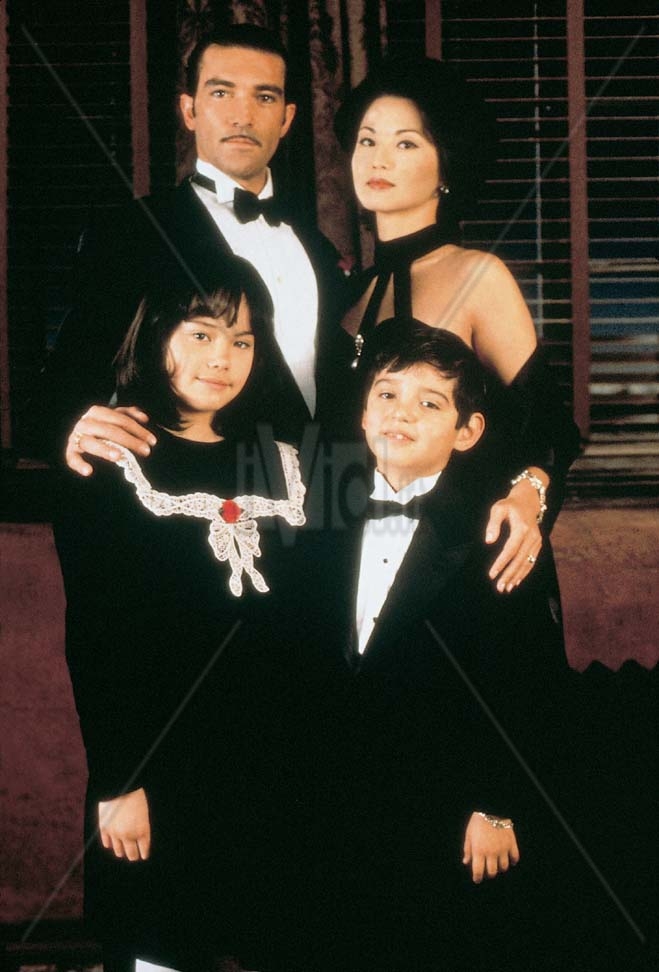The 1995 anthology title Four Rooms is a roundtable; four directors each shot a short film set in the same hotel. Though the movie was critically panned, it’s actually pretty enjoyable; the segments are all enjoyably loopy, and the Robert Rodriguez section is actually laugh out loud funny, with some great slapstick and nice turns by a couple of talented child actors.
One notable aspect of the Rodriguez segment (“The Misbehavers”) is that none of the characters is white. Tim Roth the bellhop is a prominent figure in all the segments, and he’s still there — but the family in the room is composed of Antonio Banderas as the father, Tamlyn Tomita as the Wife, and two children (played by Lana McKissack and Danny Verduzco). And yes, I think that’s the only mixed Hispanic/Asian family I’ve ever seen on film. Even the corpse in the bed is played by Robert Rodriguez’s sister, Patricia Vonne.
The rest of the segments aren’t especially racially homogenous by Hollywood standards; the opening coven-of-witches one is all white, I believe, but Jessica Beals (who is African-American) is the only person besides Roth to appear in two segments, and Paul Calderon (also African-American) shows up in Tarantino’s closing scene. Still, except for Rodriguez’s section, white people predominate.
The fact that the film is an anthology roundtable, and the fact that one of the films is so different in its approach to race, shows with unusual clarity that representation isn’t an accident, or a random function of hiring the best actors — especially since Rodriguez’s segment is pretty clearly the most inspired of the collection. Casting diverse actors is a choice — and casting white actors is a choice. Rodriguez’s room is one in which whiteness is not the default. If only white people can get into the other’s hotels, that’s because, to one degree or another, they’ve closed their doors.


I would consider Antonio Banderas white. He’s from Spain.
Hm; you’re probably right…though maybe arguable in an American context.
Well, here’s Banderas on the subject – sounds like being born in Spain hasn’t prevented him from experiencing discrimination in Hollywood:
http://latino.foxnews.com/latino/entertainment/2014/05/07/antonio-banderas-proud-hispanics-triumph-in-hollywood/
That’s fascinating. Obviously racial designations are cultural to a large degree, so categorizing people is a moving target. But he obviously identifies as Hispanic in an American context, has experienced discrimination for being Hispanic, and reads as Hispanic to at least some people (like me.) So…I guess I come down on the side of thinking it’s not wrong to refer to him as Hispanic.
It’s not wrong to refer to Banderas as Hispanic. He is Hispanic. Hispanic means you come from a Spanish-speaking country. It’s not a racial designation. It includes people from Spain, who are predominantly white, and those from Equatorial Guinea, who are predominantly black.
I think you’re confusing it with Latino, which is a racial designation for Latin Americans of Native American descent. But all Latinos are not Hispanic. Brazilians are Latino, and they speak Portuguese.
As for Banderas’ complaint about typecasting, well, I think every actor in Hollywood has to contend with this. He also didn’t speak English when he first came to Hollywood, and that would certainly limit the roles available to him.
As I said, racial designations are pretty fluid. I don’t think the Hispanic/Latino split you’re talking about there is used with any systematic consistency.
Noah,
It’s not clear to me you should concede to Robert that Hispanic is not a racial category. He is certainly in agreement with the US Census, which has separate questions for race and hispanic/latino origin. (Hispanic and Latino are synonymous for the Census folks.) But we can ask who gets to do the constructing of our social constructions.
In 2010, almost 27 million Americans identified as both what the Census calls “White alone” — checking the white box and no other on the race question — and as Hispanic. (That’s 8.7% of the US population.) It would be very interesting to know how they would have responded to a questioner who did not presuppose that Hispanic is not a racial category.
If I learned anything from the field of whiteness studies, it’s that if people can argue about whether a person or group is white then the person or group is probably not white.
That’s a good argument why racial designations are ultimately silly. The characteristics–dark hair, swarthy complexion–that mark Antonio Banderas as “not white” are true of a sizable part of the population of southern Europe. It’s true of many in the northern and eastern regions, too. And the Middle East. Which is why actors of European and ME descent such as Javier Bardem (also Spanish), Al Pacino (Italian), Natalie Wood (Russian), George Chakiris (Greek), and F. Murray Abraham (Assyrian/Italian) can play Latino characters without it seeming discordant. Or why a Latino actor such as Andy Garcia can make a name for himself playing Italian-Americans. People project stereotypical associations onto others based on appearances.
Silly yes, but silly with consequences.
I think it’s safe to say that Quentin Tarantino has, officially, never disappointed me as a director or screenwriter. My heart leapt as soon as I heard his trademark dialogue coming from the lips of Marisa Tomei as Four Rooms segued from The Misbehavers to The Man From Hollywood.
Wow…okay. I thought Four Rooms his segment of four rooms (not excluding the opening) was dreadful; the worst of his directing career, easily. But I guess mileage differs…